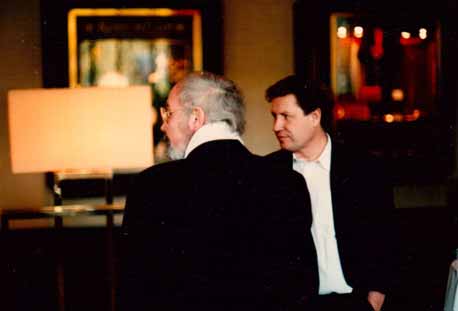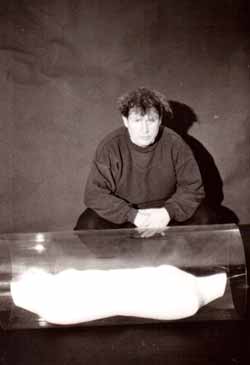Biografie Dieter Walter Liedtke
Dieter W. Liedtke was born on the 6th of July 1944 in Essen (Germany). He combines art, philosophy and research. Apart from him being an artist he is also an inventor, thinker, visionary, entrepreneur and author.
1963 he had his first exhibition in a bakery in Vienna. Since then he exhibited a lot of his work in different European countries and the United States. Amongst others in the Larchmont in New York, the Kaiserhof Gallery in Essen, the Alsterhaus in Hamburg, Karstadt in Dortmund, the Sheraton Hotel in Essen, in the Liedtke Museum in Virneburg, Essen Trade Fair as well as a special exhibition in San Gemini, Italy and the Liedtke Museum on Majorca.

Since 1986 Dieter W. Liedtke lives in the Port of Andratx on Majorca. In July 1994 he opened the Liedtke Museum in the same town. In a museum building designed by him his work is exhibited.
A new approach to understanding, in other words the search for dialogue between the different peoples and their religions becomes vivid through his work and the exhibition "Universal code". Liedtke's special interest is for research and the encouragement of creativity. His concepts are aimed to supersede social and economical problems by means of increasing human creativity, so it will be possible for every human being to live a self-determined life in dignity.
1999 he founded the non-profit foundation Fundacion Liedtke, which operates the Liedtke Museum and is dedicated to encourage the development of creativity in the population. Liedtke also acted as idea generator for various projects, e.g. the art fair "Art Forum Berlin" and the world exhibition "Expo 2000" in Hannover.
Apart from his work as an artist he developed patents and product of everyday use, e.g. the principal of audiovisual marketing nowadays in use worldwide. He is the inventor of the "Hairmatic 2000", which was promoted to be a cult product of the seventies by Franz Beckenbauer and using video promotion in department stores. His newest inventions are focused on epigenetics, media and renewable energies.

Harald Szeemann once described him as inventor-artist being quintessentionally creative. Also in a press conference held on the 7th of June 1999, Szeeman described Liedtke himself as an artwork (see also "Spinnerpotenz", DIE ZEIT, 15.07.1999). Time and again Liedtke develops innovations by his artwork, which anticipates the result of research results by years.
In the past the person in charge of the "art open" was described by various sources as an evolutionary and doer (compare WAZ, 16.01.1999, "Der Evolutionar als Macher" by Wulf Mämpel,, as well as KUNSTZEITUNG, 1998, "Evolutionär").
Dr. Thomas Föhl, director of the Weimar Art Collectionswrites: "Based on the method of conducting scientific research by means of art and philosophy, lost since the renaissance, Liedtke is the first artist after almost 5 centuries to once more achieve art and research results of the highest quality." In his work Liedtke documents research results, which are only produced by leading natural scientists years later.
Through his work Liedtke furthermore developed the theory (mid 80ies) that genes and genetic programs are controlled by information and can also be switched on or off.
In 2000 Erik Kandel receives the Nobel Prize for medicine. The research results of Erik Kandel prove that perceptions arouse new neuronal cross-links in the brain. With his paintings, sculptures and Theory of the Sandpit Model (set forth in his book "The Consciousness of Matter", 1982) Liedtke anticipated the results of Erik Kandel's research. 1983 the Museum of Modern Art New York included the book "The Consciousness of Matter" in its documentary of contemporary art.
The art historian and critic Karl Ruhrberg says Liedtke's artwork and evolutionary theories provide numerous impulses to art history and science.
Other reports also compare Liedtke with well-known personalities in history. Thus in 1991 the Italian station TELE 5 describes him as the successor of the artist Joseph Beuys. 1995 the German weekly newspaper DIE WELT published an article titled Dieter Liedtke auf den Spuren Leonardos (Dieter Liedtke on Leonardo's trail).
Liedtke's intention is not to reach the elitist circles of art with his exhibitions. He rather tries to help shaping art as a process and encourage the neuronal cross-linking and development of society by exhibitions in venues of public life. He has organised his exhibition in fair halls, department stores as well as a lorry street museum.
At the behest of Joseph Beuys Dieter Liedtke developed a graphic formula enabling everybody to recognise the history of art and its artworks as an illustrated epistemic way to boost one's own neuronal cross-linking and to take the creativity stored in its artworks into one's cognitive skills just by looking.
 From 1994 he developed the concept of the "art open" art exhibition for fair halls. By means of 1,000 original artworks from Stone Age to this day he wants to make art as an epistemic process accessible for a larger population. The "art open" took place in the Essen Trade Fair in 1999 and was open day and night; the entrance was free. Liedtke managed to win numerous companies as sponsors for his project and at the same time convinced many directors of museums as well as international art historians of the formula.
Among other things the formula was validated by the art historians Prof. Dr. Harald Szeemann, Prof. Karl Ruhrberg, Prof. Dr. Friedmann Schrenk and Prof. Niklas Luhmann, who later cooperated in the "art forum".
From 1994 he developed the concept of the "art open" art exhibition for fair halls. By means of 1,000 original artworks from Stone Age to this day he wants to make art as an epistemic process accessible for a larger population. The "art open" took place in the Essen Trade Fair in 1999 and was open day and night; the entrance was free. Liedtke managed to win numerous companies as sponsors for his project and at the same time convinced many directors of museums as well as international art historians of the formula.
Among other things the formula was validated by the art historians Prof. Dr. Harald Szeemann, Prof. Karl Ruhrberg, Prof. Dr. Friedmann Schrenk and Prof. Niklas Luhmann, who later cooperated in the "art forum".
Many museum directors have examined Liedtke's formula in terms of its art historical correctness and found it correct and revolutionary. The "art forum" was also supported by the lending of valuable artworks. Thus a few museums lend up to 70 art historical works or also key works of art history (amongst others: Tretyakov State Gallery, Moscow; The Russian Museum, St. Petersburg; Poland's National Museum in Krakow; Bundeskunsthalle Bonn; Hessisches Landesmuseum, Darmstadt; Von der Heydt Museum, Wuppertal; Weimar Art Collections of the Klassik Stiftung Weimar and the El Greco Museum in Toledo).
1999 the exhibition was closed for partly dubious reasons only five days after opening its doors.

10 years later Liedtke's idea is confirmed. The EU proclaims 2009 as the year of creativity and innovation. The aim of the European Year is the encouragement of creativity and power of innovation as key skills for everybody and to recognize and apply the role of culture in the encouragement of creativity and power of innovation
Liedtke predicts an ethnic, evolutionary capitalism for the future, which will enable the world population to live longer with creativity, prosperity and health and without the exploitation of humans.
He is aware that he can force the process of an ethnic evolution only in collaboration with museums and art historians.
Liedtke also sees his projects as conceptual art in the public space, promoting the recognition and use of creativity as a means of life throughout the width of society.
At the moment Liedtke works on two exhibition projects.
On one side the permanent worldart exhibition "art open", which exhibits in an own art open Liedtke Museum over 1,000 artworks (from Stone Age to this day) decoding their innovations.
On the other side the exhibition "Universal Code", a touring exhibition with a choice of 220 of his works, following the idea of epigenetic encouragement of creativity by the dissolution of mysticism in medicine, biology, life, matter, the universe, the creation, in order to further open the gates towards the already begun age of creativity with the formula and art (Understanding by seeing) for the width of population on a global level for a new ethnic society.
Thus he developed and realized in the world of art the following theories, concepts and models:
| Year | Event |
|---|---|
| 1969-70 | sandpitmodel, a theory over the connection of creativity, ways of thinking and evolutionism |
| 1979 |
trend in art concrete evolutionism |
| 1979-81 |
decoding system of art |
| 1984 | a philosophical physical theory about the 4th dimension, m3 t = 4d |
| 1986 | conception of the Liedtke-Museum |
| 1988 | Kunstformel: Leben/Erfahrenes + Innovation/Kreativität = Kunst, die in kürzester Form den Prozess der Kunst erklärt |
| 1988 | graphic artformula |
| 1989-90 | marking-system of art |
| 1994 | concept for the exhibition of evolution (art from the Stone Age until today) art open, in which the marking-system of art and the artformula are applied for the first time |
| 1994 | opening of the Liedtke-Museum |
| 1994-99 | Realization of the Art evolution exhibition artopen |
| 1996 |
theory about the sense of artworks in the caves of the Stone Age |
| 1996 | conclusive theory about Stonehenge |
| 1996-97 | evolutiontheory, in which he connects some of his theories to an evolutiontheory of the cognitionsystems. Thereby he prooves that illustrated cognition increases creativity and programmes the genes newly. |
| 10th of July 1999 | opening of the art open in Essen on an expositionsurface of 23.000 qm with over 1000 original artworks of noted artists. |
| 16th of July 1999 | illegal closing down of the art open in front of an political backround. |
| 1999 | Entwicklung des Event-Museums im Konkreten Evolutionismus |
| 2000 | art open-creativity-MCST-seminars (MCST) |
| 2000 | preparation of novel art open exhibition : Creativity Prosperity Liberty, measures to realize the order of Beuys |
1987-93 |
furniture and the Museum Liedtke in Port d‘An-tratx, Mallorca, for his plastics and pictures |
| 2001 | Wiedereröffnung des Museum Liedtke in Port d‘Andratx |
His books and conceptions:
| Year | Booktitle |
|---|---|
| 1982 | "The consciousness of matter" |
| 1987 | "The 4. dimension" |
| 1987 | "The AV-marketing" |
| 1990 | "The key to art" |
| 1994-99 | "die Kunstausstellung art open" |
| 1999 | "Lexika Formula art open" |
| 1998/99 | "Evolutional system of cognitive systems" |
| 2000 | "Multilevel-Creative-Spiralnetwork-Thinking" |
Books (in preparation):
| Language | Title |
|---|---|
| Spanish, German | "art reflections" |
| German | "Never without ideas" |
| Spanish, German, English | „Letter fields“ |
| German | „art open Event-and media projects“ |
| German | "dangerous art" |
| German | "world-formula" |
| Spanish, German, English | "Evolutional system of cognitive systems volume I to V" |
| Spanish | "La clave para el acceso al arte" |
Catalogues:
| Language | Title |
|---|---|
| Spanish, German, English | "Museo Liedtke" |
| Spanish, German, English | "liedtke graphics art open" |
| Spanish, German, English | "m³ t = 4D" |
| Spanish, German, English | "formula art open" |
| Spanish, German, English | "Liedtke" |
| Spanish, German, English | "concrete evolutionism" |
| Spanish, German, English | "Museum Concrete Evolutionism" |
CD-ROM`s:
| Language | Title |
|---|---|
| German | "Never without ideas" |
| Spanish, German, English | "Lexikon art formula" |
Video:
- "future transport art open 1999", German